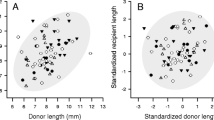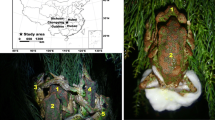Abstract
Size-assortative mating is a pattern of non-random pairing among individuals that has been presumed to arise due to the enhanced reproductive success that may accrue from mating with an individual of similar size. Its proximal mechanism may be female choice for similarly sized mates and/or large-male advantage during bouts of direct male-male competition. The hallmark for the occurrence of size-assortative mating is a significant correlation between female and male body sizes in mated pairs. In this study, we investigated the mating pattern of the emerald glass frog, Espadarana prosoblepon, whose mating system is purportedly based on female choice and therefore is a suitable study system for testing hypotheses of size-assortative mating. We specifically tested whether E. prosoblepon males found in amplexus were larger than solitary males, indicating a large-male advantage in mating and whether either larger males or size-matched pairs of frogs had a higher proportion of their eggs fertilized, consistent with a benefit to size-assortative mating. We found no evidence for any of these relationships in E. prosoblepon despite a positive correlation between female size and clutch size. Males in amplexus were not larger than unmated males, and male size did not predict the proportion of fertilized eggs. Our evidence thus indicates that the mating pattern of E. prosoblepon is random with respect to body size, in conformity with a growing body of evidence that body size is likely not a significant factor influencing mating patterns in anurans.
Significance statement
Size-assortative mating occurs when similarly sized individuals mate together more often than expected by chance. Studies addressing this question test for a correlation between female and male sizes within mating pairs, but few studies test whether mating with similarly sized individuals provides proximate benefits. Size-assortative mating should occur in species where mate choice is possible to occur, in which individuals can discriminate and choose to mate with similarly sized individuals. In frogs, many previous studies have searched for size-assortative mating, but evidence for its occurrence or selective advantage remains scant. We used the emerald glass frog, Espadarana prosoblepon, as a study system to test the predictions of size-assortative mating. We found that both mating preference and fertilization success are random with respect to body size.





Similar content being viewed by others
Availability of data and material
The datasets generated and/or analyzed during the current study are available within the article and its supplementary materials.
Code availability
Not applicable.
References
Andersson M (1994) Sexual selection. Princeton University Press, Princeton
Andersson S, Örnborg J, Andersson M (1998) Ultraviolet sexual dimorphism and assortative mating in blue tits. Proc R Soc Lond B 265:445–450
Arak A (1983) Male-male competition and mate choice in anuran amphibians. In: Bateson P (ed) Mate choice. Cambridge University Press, Cambridge, pp 181–210
Arnqvist G, Rowe L, Krupa JJ, Sih A (1996) Assortative mating by size: a meta-analysis of mating patterns in water striders. Evol Ecol 10:265–284
Basto-Riascos MC, López-Caro J, Vargas-Salinas F (2017) Reproductive ecology of the glass frog Espadarana prosoblepon (Anura: Centrolenidae) in an urban forest of the Central Andes of Colombia. J Nat Hist 51:2535–2550
Bastos RP, Haddad CFB (1996) Breeding activity of the neotropical treefrog Hyla elegans (Anura, Hylidae). J Herpetol 30:355–360
Bourne GR (1993) Proximate costs and benefits of mate acquisition at leks of the frog Ololygon rubra. Anim Behav 45:1051–1059
Briggs VS (2008) Mating patterns of red-eyed treefrogs, Agalychnis callidryas and A. moreletii. Ethology 114:489–498
Byrne PG, Roberts JD, Simmons LW (2002) Sperm competition selects for increased testes mass in Australian frogs. J Evol Biol 15:347–355
Chajma P, Vojar J (2016) The effect of size-assortative mating on fertilization success of the common toad (Bufo bufo). Amphibia-Reptilia 37:389–395
Crespi BJ (1989) Causes of assortative mating in arthropods. Anim Behav 38:980–1000
Davies NB, Halliday TR (1977) Optimal mate selection in the toad Bufo Bufo. Nature 269:56–58
Dickerson BR, Willson MF, Bentzen P, Quinn TP (2004) Size-assortative mating in salmonids: negative evidence for pink salmon in natural conditions. Anim Behav 68:381–385
Dittrich C, Rodríguez A, Segev O, Drakulić S, Feldhaar H, Vences M, Rödel MO (2018) Temporal migration patterns and mating tactics influence size-assortative mating in Rana temporaria. Behav Ecol 29:418–428
Emerson SB (1997) Testis size variation in frogs: testing the alternatives. Behav Ecol Sociobiol 41:227–235
Fan XL, Lin ZH, Ji X (2013) Male size does not correlate with fertilization success in two bufonid toads that show size-assortative mating. Curr Zool 59:740–746
Friedl TW, Klump GM (2005) Sexual selection in the lek-breeding European treefrog: body size, chorus attendance, random mating and good genes. Anim Behav 70:1141–1154
Gerhardt HC (1994) The evolution of vocalization in frogs and toads. Annu Rev Ecol Evol S 25:293–324
Gingras B, Boeckle M, Herbst CT, Fitch WT (2013) Call acoustics reflect body size across four clades of anurans. J Zool 289:143–150
Gosner KL (1960) A simplified table for staging anuran embryos and larvae with notes on identification. Herpetologica 16:183–190
Goyes Vallejos J, Ramirez-Soto K (2020) Causes of embryonic mortality in Espadarana prosoblepon (Anura: Centrolenidae) from Costa Rica. Phyllomedusa 19:83–92
Green DM (2015) Implications of female body-size variation for the reproductive ecology of an anuran amphibian. Ethol Ecol Evol 27:173–184
Green DM (2019) Rarity of size-assortative mating in animals: assessing the evidence with anuran amphibians. Am Nat 193:279–295
Han X, Fu J (2013) Does life history shape sexual size dimorphism in anurans? A comparative analysis. BMC Evol Biol 13:1–11
Harari AR, Handler AM, Landolt PJ (1999) Size-assortative mating, male choice and female choice in the curculionid beetle Diaprepes abbreviatus. Anim Behav 58:1191–1200
Howard RD, Kluge AG (1985) Proximate mechanisms of sexual selection in wood frogs. Evolution 39:260–277
Jacobson SK (1985) Reproductive behavior and male mating success in two species of glass frogs (Centrolenidae). Herpetologica 41:396–404
Jennions MD, Passmore NI (1993) Sperm competition in frogs: testis size and a ‘sterile male’ experiment on Chiromantis xerampelina (Rhacophoridae). Biol J Linn Soc 50:211–220
Jiang Y, Bolnick DI, Kirkpatrick M (2013) Assortative mating in animals. Am Nat 181:E125–E138
Kusano T, Toda M, Fukuyama K (1991) Testes size and breeding systems in Japanese anurans with special reference to large testes in the treefrog, Rhacophorus arboreus (Amphibia: Rhacophoridae). Behav Ecol Sociobiol 29:27–31
Liao WB, Lu X (2011) Proximate mechanisms leading to large male-mating advantage in the Andrew’s toad, Bufo andrewsi. Behaviour 148:1087–1102
Lu X, Ma X, Fan L, Hu Y, Lang Z, Li Z, Fang B, Guo W (2016) Reproductive ecology of a Tibetan frog Nanorana parkeri (Anura: Ranidae). J Nat Hist 50:2769–2782
Lüpold S, de Boer RA, Evans JP, Tomkins JL, Fitzpatrick JL (2020) How sperm competition shapes the evolution of testes and sperm: a meta-analysis. Phil Trans R Soc B 375:20200064
Márquez-M de Orense R, Tejedo-Madueño M (1990) Size-based mating pattern in the tree frog Hyla arborea. Herpetologica 46:176–182
Meuche I, Brusa O, Linsenmair KE, Keller A, Pröhl H (2013) Only distance matters–non-choosy females in a poison frog population. Front Zool 10:29
Mobley KB, Abou Chakra M, Jones AG (2014) No evidence for size-assortative mating in the wild despite mutual mate choice in sex-role-reversed pipefishes. Ecol Evol 4:67–78
Moura RR, Gonzaga MO, Pinto SN, Vasconcellos-Neto J, Requena GS (2021) Assortative mating in space and time: patterns and biases. Ecol Lett 24:1089–1102. https://doi.org/10.1111/ele.13690
Nali RC, Zamudio KR, Haddad CFB, Prado CPA (2014) Size-dependent selective mechanisms on males and females and the evolution of sexual size dimorphism in frogs. Am Nat 184:727–740
Ng TP, Williams GA, Davies MS, Stafford R, Rolán-Alvarez E (2016) Sampling scale can cause bias in positive assortative mating estimates: evidence from two intertidal snails. Biol J Linn Soc 119:414–419
Ortiz-Ross X, Thompson ME, Salicetti-Nelson E, Donnelly MA (2020) Oviposition site selection in three glass frog species. Copeia 108:333–340
Pettitt BA, Bourne GR, Bee MA (2020) Females prefer the calls of better fathers in a Neotropical frog with biparental care. Behav Ecol 31:152–163
R Development Core Team (2019) R: a language and environment for statistical computing. R Foundation for Statistical Computing, Vienna. http://www.R-project.org
Reynolds RG, Fitzpatrick BM (2007) Assortative mating in poison-dart frogs based on an ecologically important trait. Evolution 61:2253–2259
Robertson JGM (1990) Female choice increases fertilization success in the Australian frog, Uperoleia laevigata. Anim Behav 39:639–645
Rueger T, Gardiner NM, Jones GP (2016) Size matters: male and female mate choice leads to size-assortative pairing in a coral reef cardinalfish. Behav Ecol 27:1585–1591
Rueger T, Gardiner NM, Jones GP (2018) Site fidelity facilitates pair formation in aggregations of coral reef cardinalfish. Oecologia 186:425–434
Ryan MJ (1988) Constraints and patterns in the evolution of anuran acoustic communication. In: Fritzsch B, Hethington T, Ryan M, Wilczynski W, Walkowiak W (eds) The Evolution of the Amphibian Auditory System. John Wiley, New York, pp 37–677
Ryan MJ, Keddy-Hector A (1992) Directional patterns of female mate choice and the role of sensory biases. Am Nat 139:S4–S35
Savage JM (2002) The amphibians and reptiles of Costa Rica: a herpetofauna between two continents, between two seas. University of Chicago Press, Chicago
Shine R, O’connor D, LeMaster MP, Mason RT (2001) Pick on someone your own size: ontogenetic shifts in mate choice by male garter snakes result in size-assortative mating. Anim Behav 61:1133–1141
Sullivan BK, Ryan MJ, Verrell PA (1995) Female choice and mating system structure. In: H. Heatwole and B. K. Sullivan (eds) Amphibian biology. Surrey Beatty, Baulkham Hills, Australia, pp 469–517
Székely D, Székely P, Denoël M, Cogălniceanu D (2018) Random size-assortative mating despite size-dependent fecundity in a Neotropical amphibian with explosive reproduction. Ethology 124:218–226
Tonini JFR, Provete DB, Maciel NM, Morais AR, Goutte S, Toledo LF, Pyron RA (2020) Allometric escape from acoustic constraints is rare for frog calls. Ecol Evol 10:3686–3695
Valencia-Aguilar A, Zamudio KR, Haddad CFB, Bogdanowicz SM, Prado CPA (2020) Show me you care: female mate choice based on egg attendance rather than male or territorial traits. Behav Ecol 31:1054–1064
Wells KD (1977) The social behaviour of anuran amphibians. Anim Behav 25:666–693
Wells, KD (2007) The ecology and behavior of amphibians. University of Chicago Press, Chicago
Wogel H, Abrunhosa PA, Pombal JP (2005) Breeding behaviour and mating success of Phyllomedusa rohdei (Anura, Hylidae) in south-eastern Brazil. J Nat Hist 39:2035–2045
Yang Y, Richards-Zawacki CL (2021) Male–male contest limits the expression of assortative mate preferences in a polymorphic poison frog. Behav Ecol 32:151–158
Zhang L, Sheng Y, Yuan X, Yu F, Zhong X, Liao J, Liu Z, Chen W (2020) Proximate mechanisms responsible for random mating by size in the Himalayan toad Duttaphrynus himalayanus. Anim Biol 71:183–195
Acknowledgements
We thank Darko Cotoras, Rodolfo Quiros Flores, and Scott Walter for their invaluable support (logistic and otherwise). We thank Karim Ramirez-Soto for his help during fieldwork. We thank two anonymous reviewers whose comments greatly improved our manuscript.
Funding
Funding for this study was provided by the US National Science Foundation (grant number HRD-1712757) and the Organization for Tropical Studies which supported JGV, JG, ADHF, and RV during the NSF Louis Stokes Alliances for Minority Participation Research Experience for Undergraduate Program in 2018 and 2019 at Las Cruces Biological Station, Costa Rica.
Author information
Authors and Affiliations
Corresponding author
Ethics declarations
Ethics approval
This research was conducted under the Ministerio del Ambiente y Energía de Costa Rica (MINAE) and Sistema Nacional de Areas de Conservación (SINAC) Scientific Research Permit Number R-SINAC-PNI-ACLAP-031–2018/2019 and followed the guidelines of the Animal Behavior Society (ABS) for the treatment of animals in behavioral research.
Consent to participate
Not applicable.
Consent for publication
Not applicable.
Conflict of interest
The authors declare no competing interests.
Additional information
Communicated by K. Summers.
Publisher’s note
Springer Nature remains neutral with regard to jurisdictional claims in published maps and institutional affiliations.
Supplementary Information
Below is the link to the electronic supplementary material.
Rights and permissions
About this article
Cite this article
Goyes Vallejos, J., Gomez, J., Hernández-Figueroa, A.D. et al. Fertilization success suggests random pairing in frogs with regard to body size. Behav Ecol Sociobiol 75, 140 (2021). https://doi.org/10.1007/s00265-021-03081-6
Received:
Revised:
Accepted:
Published:
DOI: https://doi.org/10.1007/s00265-021-03081-6




